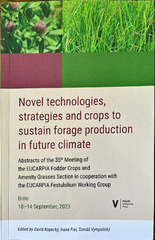Приказ основних података о документу
Isoflavones profiles of some diploid and tetraploid red clover cultivars (Trifolium pratense L.) at flowering stage
| dc.creator | Vasiljević, Sanja | |
| dc.creator | Mikulić, Mira | |
| dc.creator | Cvejić, Jelena | |
| dc.creator | Nikolić, Zorica | |
| dc.creator | Katanski, Snežana | |
| dc.creator | Mamlić, Zlatica | |
| dc.creator | Uhlarik, Ana | |
| dc.date.accessioned | 2023-10-02T08:42:39Z | |
| dc.date.available | 2023-10-02T08:42:39Z | |
| dc.date.issued | 2023 | |
| dc.identifier.isbn | 978-80-244-6341-4 | |
| dc.identifier.uri | http://fiver.ifvcns.rs/handle/123456789/3759 | |
| dc.description.abstract | Isoflavones are one of the best studied groups of phytoestrogens. Phytoestrogens are plant compounds that can exhibit a biological effect similar to the reproductive hormone estrogen. From nutritive and pharmaceutical aspect, red clover is one of the most important sources of these compounds, and they are often used as a raw material for production of dietary supplements used for alleviation of menopausal symptoms. The objective of this study was to determine the concentrations of isoflavones in 11 diploid (2n) and 10 tetraploid (4n) cultivars of red clover (Trifolium pratense L.) from different origine, in a whole plant and separately: in stems, leaves and flowers at the stage of full flowering. Herbage samples from whole and different parts of plant were dried at 60˚C for about 48 hours, homogenized and grounded to a particle size of Ӕ = 0.8 mm as well as mixed with 2 ml of water on 37°C. After that, HCl and ethanol are added and mixture is heated to boiling. Obtained extract are purified by solid phase extraction on HLB cartridges and analyzed on HPLC after filtration. Zorbax SB C 18 reversed phase HPLC column is used for separation of main isoflavones present in red clover: formononetin, biochanin A, genistein and daidzein. Isoflavones are identified by comparing the retention times in HPLC chromatograms and UV spectral patterns with those of standard compounds. Isoflavone concentrations are quantified by external standard method using five-point regression curves of formononetin, biochanin A, genistein, and daidzein standard compounds. The content of total isoflavones ranged from 3.83 (Marieta -2n cultivar) to 17.11 mg g-1 DM (Margot-4n cultivar). Red clover plant parts were significantly different according to isoflavone content. The leaf was the richest source of isoflavones (6.54 mg g-1 DM), followed by flowers (1,96 mg g-1 DM) and stem (1.16 mg g-1 DM). Biochanin A and formononetin were the predominant isoflavones in leaves, while genistein was mostly present in flowers. Tetraploid red clover cultivars (4n) had significantly higher isoflavones content compared to diploids (2n). On average, the content of isoflavones in tetraploids (11.0 mg g-1 DM) is statistically significantly higher than in diploids (8.44 mg g-1 DM). | sr |
| dc.language.iso | en | sr |
| dc.publisher | Olomouc:Palacký University Olomouc | sr |
| dc.rights | openAccess | sr |
| dc.rights.uri | https://creativecommons.org/licenses/by/4.0/ | |
| dc.source | Abstracts of the 35th Meeting of the EUCARPIA Fodder Crops and Amenity Grasses Section in cooperation with the EUCARPIA Festulolium Working Group, 10-14 September 2023, Brno | sr |
| dc.subject | red clover | sr |
| dc.subject | Trifolium pratense L | sr |
| dc.subject | isoflavones | sr |
| dc.subject | HPLC | sr |
| dc.subject | diploid (2n) | sr |
| dc.subject | tetraploid (4n) | sr |
| dc.title | Isoflavones profiles of some diploid and tetraploid red clover cultivars (Trifolium pratense L.) at flowering stage | sr |
| dc.type | conferenceObject | sr |
| dc.rights.license | BY | sr |
| dc.citation.epage | 27 | |
| dc.citation.spage | 27 | |
| dc.identifier.doi | 10.5507/vup.23.24463414 | |
| dc.identifier.fulltext | http://fiver.ifvcns.rs/bitstream/id/9615/bitstream_9615.pdf | |
| dc.type.version | publishedVersion | sr |


